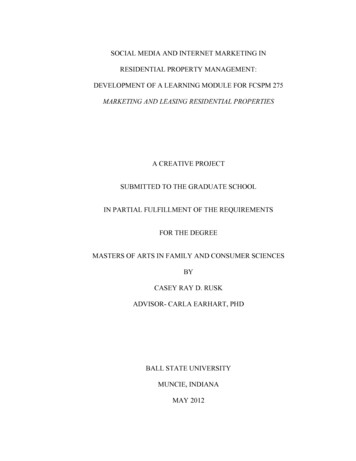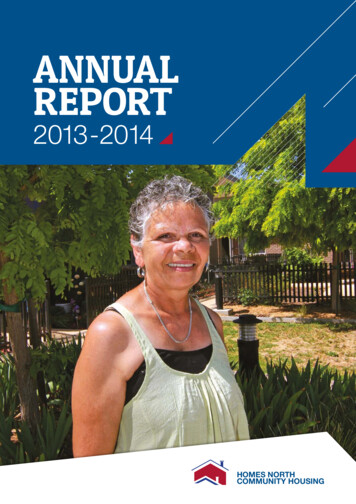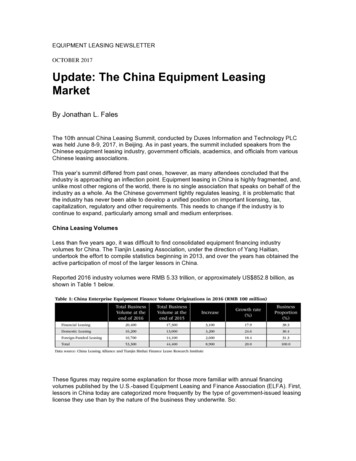
Transcription
SOCIAL MEDIA AND INTERNET MARKETING INRESIDENTIAL PROPERTY MANAGEMENT:DEVELOPMENT OF A LEARNING MODULE FOR FCSPM 275MARKETING AND LEASING RESIDENTIAL PROPERTIESA CREATIVE PROJECTSUBMITTED TO THE GRADUATE SCHOOLIN PARTIAL FULFILLMENT OF THE REQUIREMENTSFOR THE DEGREEMASTERS OF ARTS IN FAMILY AND CONSUMER SCIENCESBYCASEY RAY D. RUSKADVISOR- CARLA EARHART, PHDBALL STATE UNIVERSITYMUNCIE, INDIANAMAY 2012
iiABSTRACTCREATIVE PROJECT:Social Media and Internet Marketing in ResidentialProperty Management: Development of a Learning Modulefor FCSPM 275 Marketing and Leasing ResidentialPropertiesSTUDENT:Casey Ray Douglas RuskDEGREE:Masters of ArtsCOLLEGE:Applied Sciences and TechnologyDATE:May 2012PAGES:95Nearly 38 million households, or 33% of the United States population, are renters(National Multi Housing Council [NMHC], 2010). Individuals currently seeking a newapartment home are faced with many ways to find their new home. However, not allproperty managers or property management companies use the Internet or social mediawebsites to market their properties. Property managers and leasing professionals need todetermine if the marketing techniques they use meet the needs of the renters they hope toacquire.The researcher did an extensive literature reviews on numerous topics that includecurrent trends in apartment living, legal issues, Internet marketing, and the use of socialmedia and Internet marketing in residential property management. After the researchercompleted the literature review he created a module of learning to be taught in the Ball
iiiState University Course “Marketing and Leasing Residential Properties,” FCSPM 275.This module of learning includes PowerPoint slides, a homework assignment, and amodule quiz.
ivACKNOWLEDGEMENTSFirst, I would sincerely like to thank Dr. Carla Earhart for her time and attentionto this project; without her this would not have been possible. I would also like to thankDr. Earhart for her dedication to the Residential Property Management program. She wasthe founding director of the Residential Property Management program and I attribute itssuccess to her dedication and her genuine concern with the students’ education.Secondly, I would like to thank Dr. Jay Kandiah for the time it took her to reviewthis project and make sure it was of the highest quality possible. Dr. Jay’s open doorpolicy made it possible to ask her questions as they came up without having to wait asubstantial amount of time to receive an answer.
vTABLE OF CONTENTSPAGEABSTRACT . iiACKNOWLEDGEMENTS . .ivTABLE OF CONTENTS . .vCHAPTER 1: INTRODUCTION .1Problem Statement .3Purpose Statement .3Research Questions .3Rationale .4Assumptions .4Limitations .4Definitions.4Summary .6CHAPTER 2: REVIEW OF LITERATURE .8Background Information on FCSPM 275 .9Current Trends in Apartment Living . .10Legal Issues . .12Internet Marketing . .13Social Media Marketing . .16Uses in Residential Property Management . .17Summary . .20
viCHAPTER 3: METHODOLOGY . .22Institutional Review Board . .22Methods. .22Challenges . .24Summary . .25CHAPTER 4: RESULTS . .26CHAPTER 5: DISCUSSION . .28CHAPTER 6: CONCLUSIONS & RECOMMENDATIONS . .30BIBLIOGRAPHY . .32APPENDICIES . .35Appendix A: Current Course Syllabus FCSPM 275. .36Appendix B: Revised Course Syllabus FCSPM 275 . .37Appendix C: PowerPoint Slides. .38Appendix D: Module Assignment . .39Appendix E: Module Quiz . .40Appendix F: CITI Certificate . .41
Chapter 1: IntroductionNearly 38 million households, or 33% of the United States population, are renters(National Multi Housing Council [NMHC], 2010). Renters are a growing part of thehousing market with an interesting demographic. It has been estimated that 43% of rentalstructures have five or more units, while single-family homes comprise 34% of all rentalstructures, with the remaining rental structures compromising two to four units. In 2010,one-third of the 38 million renters (n 11 million) had an annual income less than 50,000. Overall, the mean income of the renters was approximately 35,000 (NMHC,2010). In 2009, the mean age of renters was 43 years of age. At that time, single men andsingle women made up nearly 50% of the household type, while “husband with wife”only account for 8% of the household type (NMHC, 2010).According the National Apartment Association, the apartment industry employed700,000 people in 2006, which was up 4% from 2004. The apartment industry employsthree typical position types: apartment management, apartment maintenance, andapartment leasing. Apartment management is responsible for the financial performance ofthe apartment community. Apartment maintenance is responsible for the overall upkeepof the apartment community by completing service requests that residents turn in.Apartment leasing professionals are responsible for leasing and marketing the apartment
2community and maintaining positive relationship with residents (National ApartmentAssociation [NAA], n.d.).Prior to the age of the Internet, people selected their rental homes throughrealtors, newspaper advertisements, by word of mouth, and by touring neighborhoods(Bensinger, 2007). Since the inception of the Internet and social media marketing,however, the property management workforce has another viable tool to advertise theirproperties (Wagner, 2008). Identifying consumers’ preferred rental amenities andmethods of selecting rental properties should enhance the success of any propertymanagement company.This creative project examines the existing literature on the use of Internet andsocial media marketing in the field of residential property management, and creates alearning module intended to be taught at Ball State University in FCSPM 275,“Marketing and Leasing Residential Properties.” Deliverables of the creative projectinclude a set of PowerPoint slides covering numerous topics, a homework assignment, aquiz, and a revised course syllabus.This additional knowledge will be valuable to any student preparing for a careerin Residential Property Management. A property manager and leasing professional whounderstand the factors that influence a resident’s decision-making process can design andupdate their online marketing tools to meet the consumers’ needs. In addition, it iscritical that the property management professional understands the legal issues related toonline marketing tools, which, if not used correctly, could set them up for legal action.
3ProblemIndividuals currently seeking a new apartment home are faced with many ways tofind their new home. It has been estimated that 80% of homebuyers begin their housingsearch online (Bensinger, 2007). However, not all property managers or propertymanagement companies use the Internet or social media websites to market theirproperties. Property managers and leasing professionals need to determine if themarketing techniques they use meet the needs of the renters they hope to acquire.PurposeThe purpose of this creative project is to examine the literature on the factors,characteristics, and methods used by prospective residents to find an apartment home.This information will then be used to create educational materials to teach future propertymanagement professionals how to use these marketing techniques to attract prospectiverenters.Research QuestionsThis creative project will examine the following research questions:RQ1: What does the literature show concerning the social media sites thatcurrent prospects use?RQ2: What does the literature indicate regarding the techniques thatcurrent property managers and property management companies useto market their properties?RQ3: What does the literature show concerning the legal issues involved inInternet and social media marketing?
4RQ4: What does the current National Apartment Leasing Professional(NALP) curriculum cover regarding social media techniques used inthe industry?RationaleIt is in the experience of the author that few residential property managementcompanies currently use the Internet and social media outlets to their full advantage.Identifying specific online characteristics desired by prospective residents should aid inthe development of an online marketing and social media campaign. Such a marketingplan should increase consumers’ awareness, increase occupancy, and therefore, increase aproperty management company’s profits.AssumptionsBy creating this project and investing the time to create a module of learning to betaught at Ball State University in the course FCSPM 275, the researcher’s majorassumption is that the course will continue to be taught in the Residential PropertyManagement curriculum. It is further assumed that the National Apartment LeasingProfessional curriculum will be used as the foundation of the course.LimitationsSocial media in and of itself is a fairly new topic, as is the field of residentialproperty management. Research on either topic is limited, and studies that combine bothtopics are even more scarce.DefinitionsFor the purpose of this creative project, the following definitions will be used:
5 Social media – uses Internet-based technologies that facilitate thecreation and exchange of user-generated content. Social media refers towebsites that permit people to interact with the site and with each otherusing simple interfaces. When “Guide to the Top 16 Social MediaResearch Questions,” was published in 2010, Facebook, qq.com,Twitter and YouTube were among the most popular social media sites(Longo, 2010). Facebook – is more than just a website; it is a network unprecedentedand unlike any other website in existence (McElvain & Smyth, 2006).Facebook is an online directory that connects people though socialnetworks. Twitter – is a social media website like Facebook, but Twitter is a muchmore active form of social communication in which the way the usercommunicates with people on the social network emerges as muchmore conversational. The main difference between Facebook andTwitter is Facebook limits the users’ status updates to more than 63,000characters but Twitter limits the users characters to a mere 140(Tagtmeier, 2010). Property Management Company – is responsible for running day to dayoperations for a rental property including maintenance, rent collection,move ins, move outs, lease renewals and evictions and marketing.Property management companies are also responsible for completing
6the paperwork for maintaining compliance standards with federalhousing agencies (Paris, 2006). Fair Housing- According to Collins (2010) the Fair Housing Act (FHA)of 1968 was established to stop discrimination against people based onrace, color, religion and national origin. In 1974 the protected class ofsex was added to the original four protected classes. The Fair HousingAct Amendments of 1988 added two new protected classes; familialstatus and handicapped (National Apartment Association EducationInstitute, 2012). LinkedIn – is a social networking site that allows the user to learn aboutanother contact’s interests, making it a great resource to help the userbuild a strong relationship (Comer, 2011). Web analytics – monitor data that helps the website developerdetermine if their social media profile is increasing traffic to the firm’swebsite (Winerberg, 2010).SummaryWhen nearly 38 million households in America are renters and when researchindicates customers are using less traditional ways (e.g., social media and the Internet) tofind a place to live, it is important to make sure a company’s marketing plan is meetingthe needs of its target market (Bensinger, 2007). By creating a learning module to betaught at Ball State University in FCSPM 275, “Marketing and Leasing ResidentialProperties,” the researcher anticipates that the learning module will teach future propertymanagement professionals how to market to people that are using less traditional methods
7to find a new home. Again, the researcher will examine existing literature to discover theanswers to questions like what websites are property management professionals usingand what avenues are prospective renters using to find a new home. Unless propertymanagement companies adopt marketing methods that align with current trends, they areat risk of losing potential residents.
Chapter 2: Review of LiteratureThis creative project examines the existing literature on the use of Internet andsocial media marketing in the field of residential property management, and creates amodule of learning intended to be taught at Ball State University in FCSPM 275,“Marketing and Leasing Residential Properties.” Deliverables of the creative projectinclude a set of PowerPoint slides covering numerous topics related to social media andInternet marketing, a quiz, a homework assignment, and a revised course syllabus.There is very little research related to the use of the Internet and social mediamarketing in the field of residential property management. As a result, it is necessary tofirst examine the issues in a broader sense before specifically addressing the applicationof social media marketing in this industry.This additional knowledge will be valuable to any student preparing for a careerin residential property management. When the property management workforceunderstands factors that influence a resident’s decision-making process, they can designand update their online marketing tools to meet the consumers’ needs. If propertymanagers and property management companies are educated on these issues they cansave a tremendous amount of time and money and better serve their prospective residents.
9Background Information on FCSPM 275Ball State University and the Residential Property Management (RPM) Programfirst began to offer FCSMR 275 in the spring of 2002. The course used materials from theNational Apartment Leasing Professional (NALP) designation from the NationalApartment Association Education Institute (NAAEI) as its curriculum. In the fall of 2008,faculty in the program had the opportunity to reach more students by also offering thecourse online through the university’s Independent Learning Program (ILP). During the2009 academic year the prefix to the course was changed from FCSMR to FCSPM,specifically identifying the course as a property management course in the Department ofFamily and Consumer Sciences (C. Earhart, personal communication, January 15, 2011).Since the inception of the course the NALP handbook has only been changed twice, withonly minor revisions (H. Campbell, personal communication, January 18, 2011).According to the Ball State Registration and Academic Progress website (2012) thecourse description of the course is, “Attracting and retaining qualified residents is thefoundation of the multi-family housing industry. Through hands-on activities andinvestigations, the appropriate skills for successfully marketing and leasing of residentialproperties are provided.” To get a better understanding of the course the author hasprovided the current course syllabus in Appendix A.The National Apartment Leasing Professional handbook and FCSPM 275 covernumerous topics such as: Keys to success in leasing Telephone presentations
10 Leasing and the Internet The leasing interview Leasing demonstration and resolving objections Rental policies and procedures Legal aspects.After students have studied all of the above information they are required to investigate avariety of apartment communities. The student evaluates the leasing consultant at eachcommunity based on the best practices learned in the course. After gathering all of therequired information, the students will then present their findings to their classmates andtheir instructor.The current section on Leasing and the Internet focuses on online advertising butonly on apartment specific websites like apartments.com, apartmentguide.com, andrent.com. This section also explains how to maximize online advertising. The author ofthe current NALP handbook suggests including pricing, amenities, floor plans,photographs, and virtual tours, but does not mention using Facebook or Twitter. Theother main focus of this section is on email etiquette and email signatures.Current Trends in Apartment LivingNearly 38 million households, or 33% of the United States population, are renters(National Multi Housing Council [NMHC], 2010). Forty-three percent of rentalstructures have five or more units, while single-family homes comprise 34% of all rentalstructures. In 2010, one-third of the 38 million renters (n 11 million) had an annual
11income less than 50,000. Overall, the mean income of the renters was approximately 35,000 (NMHC, 2010).In 2010 the mean age of renters was 43 years. Single men and single womenmade up nearly 50% of the household type while “husband with wife” only account for8% of the household type in 2009 (NMHC, 2010). Nearly 9% of all renters lived alone,while 12% of renters lived with four or more people (NMHC, 2010). In 2009, Indianahoused 510,000 renters; Ohio housed 961,000 renters; Kentucky housed 301,000 renters;Illinois housed 1,309,000 renters and Michigan housed 769,000 renters (NMHC, 2010).According to The State of the Nation’s Housing 2011, the rental market gainedstrength in 2011 (Joint Center, 2011). Demand for rental housing was up while vacancyrates were down which caused an increase in rental rates. From 2006 to 2010, the numberof renter households grew by nearly 700,000 annually to nearly 37 million total, while thenumber of households fell by nearly 210,000 annually. This study also indicates thatthere are two major reasons for this shift: the number of renters who have delayed homebuying grew and the number of owners who have switched back to renting has alsogrown.With apartment living growing rapidly it is important to have a trained andprofessional staff in place. As mentioned before the apartment industry employed700,000 people in 2006 (NAA, n.d.). More recent numbers were unavailable at the timethis project was published but if we assume the number of people employed by theapartment industry grows in proportion to the number of people living in apartmenthomes it can be inferred that more than three quarters of a million people should beeducated on social media and Internet marketing as it relates to the apartment industry.
12Legal IssuesSteinman and Hawkins (2010) evaluated the legal risks inexperienced companiesface when using social media, defined as sites like Facebook, Twitter, and LinkedIn, as amarketing tool. The authors discussed specific legal topics associated with the use ofsocial media to include: Trademark and copyright issues Complying with the terms and conditions of social media outlets Social media content Sweepstakes, contests, and other promotions Privacy and data security issues Retention of records related to use of social mediaThe authors introduced five court cases and explained how legal action could have beenavoided. This article provides an excellent foundation for how to avoid legal action forany person or organization starting their social media marketing debut.In addition to traditional email messages that are sent from one person’s emailserver to another, an often overlooked and more recently used application of CAN-SPAM(Controlling the Assault of Non-Solicited Pornography And Marketing Act of 2003)includes messages sent within a social networking forum (Thomas, 2010). CAN-SPAMrequires that, before marketing e-messages are sent, the sender cleans its mailing listagainst its own internally maintained opt-out list. Additionally when the message is sentit must include a mechanism that allows consumers to opt-out of receiving future emails,include the sender’s physical address, and, if the message is unsolicited, indicate that themessage is advertising (Thomas, 2010).
13Social media marketing can and will be a great tool for property managementcompanies, if used correctly. Just as property managers and leasing professionals have toabide by Fair Housing laws, property managers and leasing professionals will have toabide by Internet marketing laws. If a law is broken the management company should beprepared to pay the consequences.Internet MarketingAccording to Reinger (2007), the research director at Media-Screen, a SanFrancisco-based research firm that was founded when consumer adoption of the Webwent mainstream, the Internet stands apart from other media outlets in that it enables its“users” to interact. With the growth of online participation, consumers have greatinfluence over the products and brands considered for purchase. Reigner (2007) reportedthe total time spent online is divided as follows: 27% communications 27% leisure or entertainment 19% news or information 15% personal productivity 12% shopping.Reigner (2007) defined five types of people who shop online: 1) online insiders 2)social clickers, 3) content kings, 4) everyday pros, and 5) fast trackers. “Online insiders”are very active on the Internet and highly influential online shoppers. “Social clickers”are heavy communicators online; they tend to be younger and less affluent. “Contentkings” tend to be young, males addicted to online entertainment, and spend the leastamount of time communicating online other than activities that support their interests in
14entertainment. “Everyday pros” participate in activities that relate to online shopping(e.g., they will rate or review products, but not publish a personal page or blog). “Fasttrackers” are perceived as being too interested in using the Internet to meet theirimmediate needs such as checking news, weather or sports; they want to “get on and getoff” quickly, acting primarily as receivers of information rather than creators orproducers (Reinger, 2007).“Online insiders” and “social clickers” account for 31% of their time being spentreviewing products and 25% posting to forums. Applying these four categories to thefield of residential property management, if an “online insider” or “social clicker” shopsfor an apartment community or lives in an apartment community and has a badexperience, they are more likely to write about it on the Internet than the 4% of peoplewho say they would complain to management (Reinger, 2007).According to Wagner (2008), a contributing author at the Institute of Real EstateManagement, online marketing indicates residential property managers can more readilyattract residents to their apartment communities. Craigslist generates 7% of rentals forAvalonBay Communities, Inc., which consists of 50,000 luxury apartment homes inabout 180 markets across the country. For the most part, property managers are notdropping their print advertising, which is still the most successful way to generate leadsand get leases signed. Rather, managers are supplementing their print advertisement withInternet marketing to reach those that do not look at their print advertisement (Wagner,2008). In addition to having a website where consumers can instantly find anyinformation about the property, an online classified advertisement should be professionallooking, yet not overloaded with information. Other tips include offering detailed
15descriptions, posting advertisements with photographs, paying attention to the headline,including pertinent contact information and keeping the advertisement up-to-date(Wagner, 2008). A major provider of Craigslist support to the multi-family housing isRentSentiel. RentSentinel is a website that allows its users to create advertisements andpost them directly to Craigslist without violating the terms and agreements.Years ago, to draw potential renters, properties relied on eye-catching, colorfulbrochures that were sent out by mail. Today, many rental property managers haveupgraded to websites and e-mail enabling prospects to request information (Iannucci,2007). According to Iannucci (2006), a contributing editor at Multi-Housing News,VaultWare published statistics in its 2006 Market Index Report. The report includesstatistics indicating the soaring usage of the Internet in the apartment industry. The reportshowed a 95% increase in people viewing current apartment availability online from2005 to 2006 and a 307% increase from 2004 to 2006. There was a 66% increase from2005 to 2006 in online apartment reservations; between 2004 and 2006 there was a 262%increase in online apartment reservations (Iannucci, 2007). According to Alter (2009), thesecret is to invest in the staff and the services an apartment community can provide, andto keep the lines of communication open with residents.Other new online tools include furniture placement tools, search engineoptimization and Google maps. According to Iannucci (2007), Google maps provide amore interactive mapping technology that is appealing to users. It also allows placementof other ‘objects” on the map, such as schools, shopping and employers. Search engineoptimization or pay per click advertising helps a community to generate new leads.Making the site search friendly is critical by using keywords, text links and external links
16so the website can earn better positioning on Google and other organic search engines(Iannucci, 2007).Web analytics allow a company to see how people are using a site. If a person isvisiting the site they are more likely to be more than a cold lead. However, a largenumber of viewers might leave the site without making it to an actionable end. Websiteanalytics can help determine why, as well as what information people want and thereasons they are having trouble finding it (Hernon, 2004).It is known that shopping for an apartment and a single-family home is the sameprocess. The buyer or renter narrows down an area that in convenient for them to live,they then begin to research the area to find available homes or apartment community. Thebuyer or renter then contacts a realtor or the specific apartment community to checkavailability. With an explosion in sites dedicated to listing, appraising and discussingavailable homes, the Internet has taken a central role, with 80% of buyers now beginningtheir search online (Bensinger, 2007). If sites like this for single-family homes arebecoming more popular it can be inferred that these sites are also becoming more popularfor multi-family housing.Social Media MarketingMerely focusing on increased Twitter followers or Facebook friends is likerapidly handing out business cards at a party. To be specific, a marketing professional canadvertise through social media networks faster than with traditional media because themarketer can tap into other people’s “social graphs,” which is the new Facebookbuzzword for friend lists, follower counts, and fan base (Volmar, 2010). Traditionalcustomer relationship management is about transaction, but social media customer pa
According the National Apartment Association, the apartment industry employed 700,000 people in 2006, which was up 4% from 2004. The apartment industry employs three typical position types: apartment management, apartment maintenance, and apartment leasing. Apartment management is responsible for the financial performance of the apartment .










